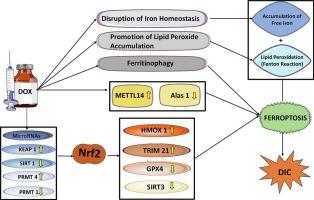铁下垂在阿霉素诱导的心脏毒性中的作用-最新进展
IF 5.1
2区 医学
Q1 MEDICINE, RESEARCH & EXPERIMENTAL
引用次数: 0
摘要
阿霉素是一种化疗药物,用于治疗多种癌症,如血癌、膀胱癌、乳腺癌、淋巴系统癌、胃癌、神经母细胞癌等。目前,它的潜力受到严重限制,因为它会导致心脏毒性,一种致命的副作用。在过去的几十年里,已经进行了几项研究来阐明这种阿霉素诱导的心脏毒性的分子机制。本研究旨在分析铁下垂在阿霉素诱导的心脏毒性机制中的作用,这是一个相对未被探索的领域。本文阐述了铁下垂的分子发病机制及阿霉素在引发铁下垂中的作用。阿霉素可影响多种生物通路,尤其是Nrf2(核因子-红细胞2相关因子2)介导的通路,导致铁下垂。研究阿霉素诱导的心脏毒性的分子机制有助于制定缓解心脏毒性和改善阿霉素使用结果的治疗干预措施,例如靶向铁蛋白噬噬,这是导致铁中毒的关键因素之一,可以减少心脏毒性,并可能成为一种潜在的治疗策略。本文章由计算机程序翻译,如有差异,请以英文原文为准。

The role of ferroptosis in doxorubicin-induced cardiotoxicity – An update
Doxorubicin is a chemotherapeutic drug used in the treatment of a variety of cancers, such as cancer of the blood, bladder, breast, lymph system, stomach, neuroblasts, etc. Currently, its potential is severely limited as it leads to cardiotoxicity, a fatal side effect. Several studies have been carried out in the past few decades to elucidate the molecular mechanisms of this Doxorubicin-induced cardiotoxicity. This study aims to analyse the role of ferroptosis in the mechanism of Doxorubicin-induced cardiotoxicity, an area which remains comparatively unexplored. The article elaborates on the molecular pathogenesis of ferroptosis and the role of doxorubicin in triggering the same. Several biological pathways, especially Nrf2 (Nuclear factor erythroid 2-related factor 2)-mediated pathways, are influenced by doxorubicin, leading to ferroptosis. The study of molecular mechanisms of doxorubicin-induced cardiotoxicity is instrumental for developing therapeutic interventions that alleviate cardiotoxicity and improve the outcomes of doxorubicin usage, such as targeting ferritinophagy, which is one of the key factors in causing ferroptosis, and can reduce cardiotoxicity and can be a potential therapeutic strategy.
求助全文
通过发布文献求助,成功后即可免费获取论文全文。
去求助
来源期刊

Life sciences
医学-药学
CiteScore
12.20
自引率
1.60%
发文量
841
审稿时长
6 months
期刊介绍:
Life Sciences is an international journal publishing articles that emphasize the molecular, cellular, and functional basis of therapy. The journal emphasizes the understanding of mechanism that is relevant to all aspects of human disease and translation to patients. All articles are rigorously reviewed.
The Journal favors publication of full-length papers where modern scientific technologies are used to explain molecular, cellular and physiological mechanisms. Articles that merely report observations are rarely accepted. Recommendations from the Declaration of Helsinki or NIH guidelines for care and use of laboratory animals must be adhered to. Articles should be written at a level accessible to readers who are non-specialists in the topic of the article themselves, but who are interested in the research. The Journal welcomes reviews on topics of wide interest to investigators in the life sciences. We particularly encourage submission of brief, focused reviews containing high-quality artwork and require the use of mechanistic summary diagrams.
 求助内容:
求助内容: 应助结果提醒方式:
应助结果提醒方式:


